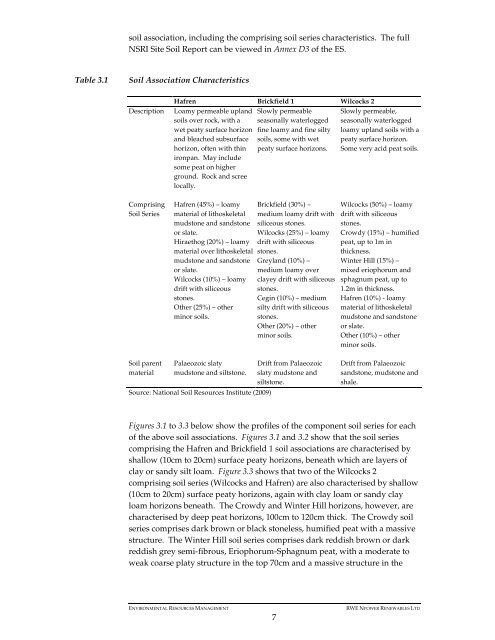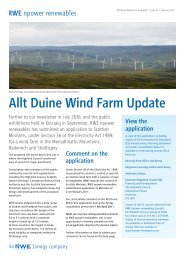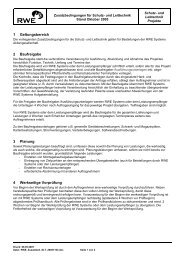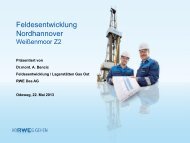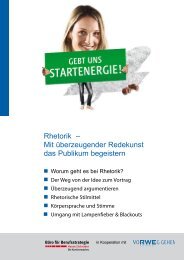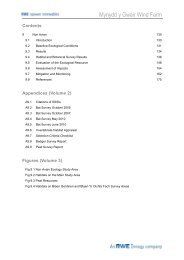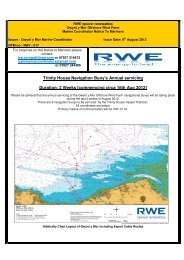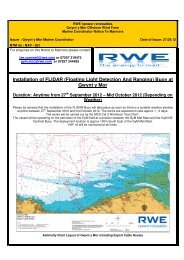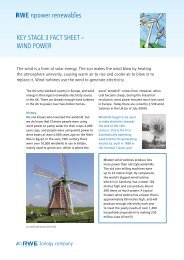F. Geology & Hydrology ( PDF | 31.0 MB ) - RWE.com
F. Geology & Hydrology ( PDF | 31.0 MB ) - RWE.com
F. Geology & Hydrology ( PDF | 31.0 MB ) - RWE.com
You also want an ePaper? Increase the reach of your titles
YUMPU automatically turns print PDFs into web optimized ePapers that Google loves.
soil association, including the <strong>com</strong>prising soil series characteristics. The full<br />
NSRI Site Soil Report can be viewed in Annex D3 of the ES.<br />
Table 3.1 Soil Association Characteristics<br />
Hafren Brickfield 1 Wilcocks 2<br />
Description Loamy permeable upland<br />
soils over rock, with a<br />
wet peaty surface horizon<br />
and bleached subsurface<br />
horizon, often with thin<br />
ironpan. May include<br />
some peat on higher<br />
ground. Rock and scree<br />
locally.<br />
Comprising<br />
Soil Series<br />
Soil parent<br />
material<br />
Hafren (45%) – loamy<br />
material of lithoskeletal<br />
mudstone and sandstone<br />
or slate.<br />
Hiraethog (20%) – loamy<br />
material over lithoskeletal<br />
mudstone and sandstone<br />
or slate.<br />
Wilcocks (10%) – loamy<br />
drift with siliceous<br />
stones.<br />
Other (25%) – other<br />
minor soils.<br />
Palaeozoic slaty<br />
mudstone and siltstone.<br />
Source: National Soil Resources Institute (2009)<br />
Slowly permeable<br />
seasonally waterlogged<br />
fine loamy and fine silty<br />
soils, some with wet<br />
peaty surface horizons.<br />
Brickfield (30%) –<br />
medium loamy drift with<br />
siliceous stones.<br />
Wilcocks (25%) – loamy<br />
drift with siliceous<br />
stones.<br />
Greyland (10%) –<br />
medium loamy over<br />
clayey drift with siliceous<br />
stones.<br />
Cegin (10%) – medium<br />
silty drift with siliceous<br />
stones.<br />
Other (20%) – other<br />
minor soils.<br />
Drift from Palaeozoic<br />
slaty mudstone and<br />
siltstone.<br />
Slowly permeable,<br />
seasonally waterlogged<br />
loamy upland soils with a<br />
peaty surface horizon.<br />
Some very acid peat soils.<br />
Wilcocks (50%) – loamy<br />
drift with siliceous<br />
stones.<br />
Crowdy (15%) – humified<br />
peat, up to 1m in<br />
thickness.<br />
Winter Hill (15%) –<br />
mixed eriophorum and<br />
sphagnum peat, up to<br />
1.2m in thickness.<br />
Hafren (10%) - loamy<br />
material of lithoskeletal<br />
mudstone and sandstone<br />
or slate.<br />
Other (10%) – other<br />
minor soils.<br />
Drift from Palaeozoic<br />
sandstone, mudstone and<br />
shale.<br />
Figures 3.1 to 3.3 below show the profiles of the <strong>com</strong>ponent soil series for each<br />
of the above soil associations. Figures 3.1 and 3.2 show that the soil series<br />
<strong>com</strong>prising the Hafren and Brickfield 1 soil associations are characterised by<br />
shallow (10cm to 20cm) surface peaty horizons, beneath which are layers of<br />
clay or sandy silt loam. Figure 3.3 shows that two of the Wilcocks 2<br />
<strong>com</strong>prising soil series (Wilcocks and Hafren) are also characterised by shallow<br />
(10cm to 20cm) surface peaty horizons, again with clay loam or sandy clay<br />
loam horizons beneath. The Crowdy and Winter Hill horizons, however, are<br />
characterised by deep peat horizons, 100cm to 120cm thick. The Crowdy soil<br />
series <strong>com</strong>prises dark brown or black stoneless, humified peat with a massive<br />
structure. The Winter Hill soil series <strong>com</strong>prises dark reddish brown or dark<br />
reddish grey semi-fibrous, Eriophorum-Sphagnum peat, with a moderate to<br />
weak coarse platy structure in the top 70cm and a massive structure in the<br />
ENVIRONMENTAL RESOURCES MANAGEMENT <strong>RWE</strong> NPOWER RENEWABLES LTD<br />
7


